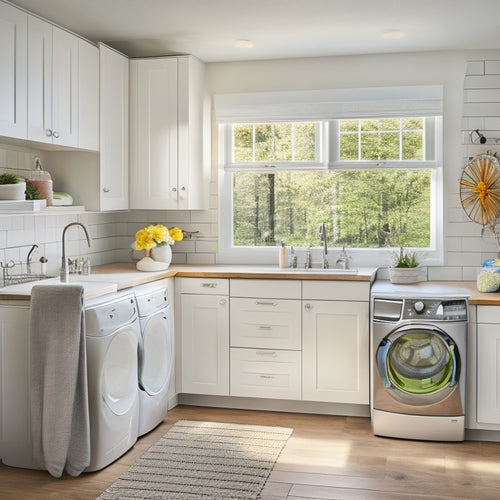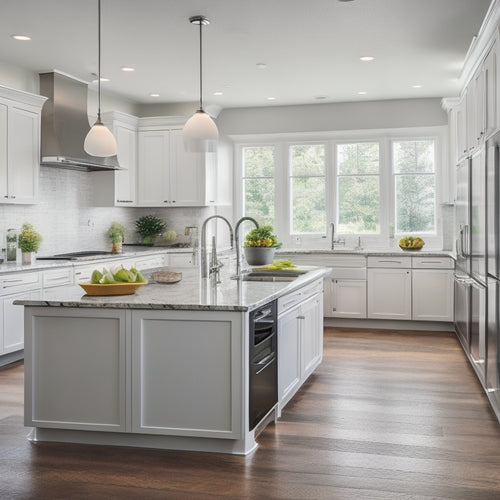
Streamline Your Kitchen: Utensil Drawer Organization Tips
Share
To streamline your kitchen, start by emptying your utensil drawer and evaluating what you need. Identify duplicates, and create a strategy for organizing your utensils. Measure your drawer and consider a customizable insert system. Categorize utensils by type, and utilize color coding to make them easy to find. Assign zones for each category, and group utensils by function. Implement a 'divide and conquer' strategy to maximize storage space. With a solid plan in place, you'll be well on your way to a clutter-free kitchen - and there's more to explore to take your organization to the next level.
Key Takeaways
• Assess your utensil drawer contents, identifying duplicates and needed items to create an organizing strategy with designated zones.
• Choose the right organizer system by taking precise measurements and considering insert materials, styles, and customizable options.
• Maximize storage space with tiered inserts, hanging hooks, cabinet door racks, and storage boards to create an efficient kitchen.
• Divide utensils into categories, assigning specific zones for each, and use color coding for easy categorization and quick retrieval.
• Regularly tidy up the utensil drawer, wiping down utensils before storing, and removing broken or duplicate items to maintain organization.
Assessing Your Utensil Drawer Needs
Take stock of your utensil drawer's current state by emptying its contents onto a countertop or table, giving you a clear view of what you have and how you can optimize the space. This is the first step in the decluttering process, allowing you to assess what you need and what you can let go of.
As you sort through your utensils, consider your utensil selection and identify any duplicates or unnecessary items. This will help you streamline your collection and make the most of your drawer's space.
Next, think about your drawer layout and how you can create an organizing strategy that works for you. Consider the frequency of use and the size of each utensil, grouping similar items together and placing the most-used items front and center.
You may also want to designate specific zones within the drawer for specific types of utensils, such as a section for baking tools or a section for cooking utensils. By taking the time to assess your needs and plan your approach, you'll be well on your way to a more organized and functional utensil drawer.
Choosing the Right Organizer System
When selecting the appropriate organizer system for your utensil drawer, you'll want to ponder a few key factors.
You'll need to take precise measurements of your drawer to guarantee a perfect fit, and think about how to categorize your utensils to maximize storage efficiency.
Drawer Measurement Matters
Measure your utensil drawer carefully to guarantee you choose an organizer system that fits snugly and maximizes storage space. Take note of the drawer's depth, width, and any obstructions, such as hinges or tracks. This will help you select an organizer that fits perfectly and optimizes the available space.
When selecting an organizer, consider the insert materials and styles that suit your needs. You can choose from a variety of materials, such as wood, plastic, or metal, each with its own benefits. For example, wooden inserts provide a natural look and feel, while plastic inserts are easy to clean and resistant to moisture.
Think about the style of your kitchen and the type of utensils you need to store. Do you prefer a modern, sleek design or a more traditional look? Do you need to store long, thin utensils like whisks and spatulas, or bulky items like pots and pans? By considering these factors, you can choose an organizer that not only fits your drawer but also meets your specific needs and preferences.
Utensil Type Classification
By categorizing your utensils into types, such as cooking, baking, and serving, you'll be able to determine the specific storage needs of each group and choose an organizer system that accommodates them efficiently.
This classification will help you identify the utensils you use most frequently and those that can be stored away.
Here are some benefits of utensil type classification:
- You'll be able to allocate space according to the frequency of use, ensuring easy access to your most-used utensils.
- Color coding can be used to differentiate between categories, making it easy to locate specific utensils.
- You'll be able to group similar utensils together, reducing clutter and making cleaning easier.
- This system will help you identify any duplicate utensils, allowing you to declutter and streamline your collection.
Customizable Insert Options
Now that you've categorized your utensils, how do you choose an organizer system that fits your specific needs, taking into account the unique characteristics of each utensil type?
You'll want to ponder customizable insert options that cater to your utensil collection. Look for drawer dividers with design options that allow you to separate utensils into distinct groups. For instance, you can have a section for baking utensils, another for cooking tools, and a third for serving pieces.
Customized compartments can be a game-changer in maximizing your drawer space. Deliberate inserts with adjustable dividers, which enable you to create compartments of varying sizes. This flexibility is particularly useful for accommodating utensils of different lengths and widths.
Organizing tips include grouping similar utensils together, placing frequently used items in easy-to-reach locations, and reserving deeper compartments for less frequently used items. By choosing an organizer system that's tailored to your needs, you'll be able to maintain a clutter-free utensil drawer and make the most of your kitchen space.
Measuring for a Perfect Fit
You'll want to take exact inventory of your utensils and the space available in your drawer to ensure a seamless fit. This step is essential in customizing inserts that will efficiently store your utensils.
Measure the length, width, and height of your drawer to determine the best layout. Consider the size and shape of your utensils, as well as how you want to group them.
- Take note of any obstructions, such as drawer dividers or utensil holders already installed
- Record the measurements of each utensil, including length, width, and thickness
- Identify any utensils that require special storage, such as sharp knives or delicate serving pieces
- Determine the frequency of use for each utensil to prioritize easy access
Maximizing Vertical Storage Space
With your measurements in hand, it's time to capitalize on the often-wasted vertical storage space in your utensil drawer by incorporating tiered inserts or stackable trays. This will enable you to store more items within the same footprint, keeping your countertops clear and your utensils organized.
Consider installing hanging hooks or wall shelves near your utensil drawer to hang items like utensil holders, oven mitts, or even a kitchen towel. This will free up space in your drawer for more frequently used items.
Don't forget to explore other vertical storage opportunities outside of your utensil drawer. Cabinet door racks can be used to store spices, oils, or other small items, while keeping them easily accessible.
Additionally, you can utilize the back of a cabinet door to hang a storage board or a pegboard, further increasing your storage capacity. By maximizing your vertical storage space, you'll be able to create a more streamlined and efficient kitchen.
Dividing and Conquering Utensils
Now that you've optimized your utensil drawer's vertical storage, it's time to tackle the chaos within.
To truly conquer the clutter, you'll need to separate your utensils into manageable groups. You can do this by categorizing them into distinct types and assigning specific zones within the drawer for each.
Utensil Categories
Divide your utensils into categories, such as baking, cooking, serving, and prep tools, to create a system that makes sense for your kitchen workflow. This will help you find what you need quickly and efficiently. Consider categorizing your utensils based on their function, frequency of use, or the type of meal you're preparing.
Here are some examples of utensil categories to get you started:
-
Baking Utensils: Whisks, spatulas, and pastry brushes
-
Cooking Utensils: Tongs, spoons, and slotted spoons
-
Serving Utensils: Serving spoons, forks, and knives
- Prep Utensils: Peelers, graters, and garlic presses
When categorizing, think about your personal preferences, such as color coding or material preference. For instance, you might prefer to group your stainless steel utensils together or separate your wooden utensils from your silicone ones.
Utensil Zones
You can further refine your utensil organization system by creating zones within your drawer, assigning specific areas to each category to maintain a clutter-free and functional space. This approach, also known as 'dividing and conquering,' guarantees that similar utensils are stored together, making them easy to find and access.
Create zones for cooking utensils, baking utensils, serving utensils, and prep utensils. Within each zone, use color coding to categorize utensils further. For instance, you can use red labels for cooking utensils, blue for baking, and green for serving. This visual system helps you quickly identify where each utensil belongs.
To maximize storage and keep utensils organized, consider using an utensil caddy or divider within each zone. This will prevent utensils from getting jumbled together and make it easy to retrieve the one you need. By implementing utensil zones, you'll be able to maintain a tidy and functional kitchen drawer that saves you time and stress.
Maintaining Your Organized Drawer
Set a regular reminder to tidy up your utensil drawer every few weeks to prevent clutter from building up again. This drawer maintenance is essential to maintaining the organization and functionality you've worked hard to achieve.
A quick cleaning and reorganization can make a huge difference in the overall look and feel of your kitchen.
Here are some tips to help you maintain your organized drawer:
-
Clean as you go: Wipe down utensils before putting them away to prevent grease and food residue from accumulating.
-
Put things back: Make it a habit to return utensils to their designated zones after use.
-
Label and categorize: Ensure that labels are still intact and categories make sense. Adjust as necessary.
- Purge unnecessary items: Get rid of broken or duplicate utensils to keep your drawer clutter-free.
Related Posts
-

Revamp Your Laundry Room With Smart Space-Saving
You're tired of feeling cramped and disorganized in your laundry room, and it's time to revamp the space to make the ...
-

5 U-Shaped Kitchen Layout Ideas to Revamp Your Space
You're about to reveal the secret to a kitchen that's both stunning and supremely functional, where every inch of spa...

